Healthcare Revenue Management: Sources, Challenges, and Solutions
VerifiedAdded on 2019/10/30
|7
|1502
|44
Report
AI Summary
This report provides an in-depth analysis of revenue management within healthcare organizations. It begins by outlining the diverse sources of revenue, including government funding, direct patient payments, private donations, and insurance premiums. The report then delves into the challenges faced by healthcare providers in managing their revenue streams, such as difficulties in collecting payments from patients, inadequate technology adoption, insufficient monitoring of the claims process, lack of trained staff, and the absence of comprehensive financial policies. The report also emphasizes the importance of rates negotiation with payers and the use of spreadsheets to determine the rate of the present day and how to bill payers. By highlighting these key areas, the report offers a comprehensive understanding of the complexities of revenue management in healthcare and the strategies needed for financial sustainability.
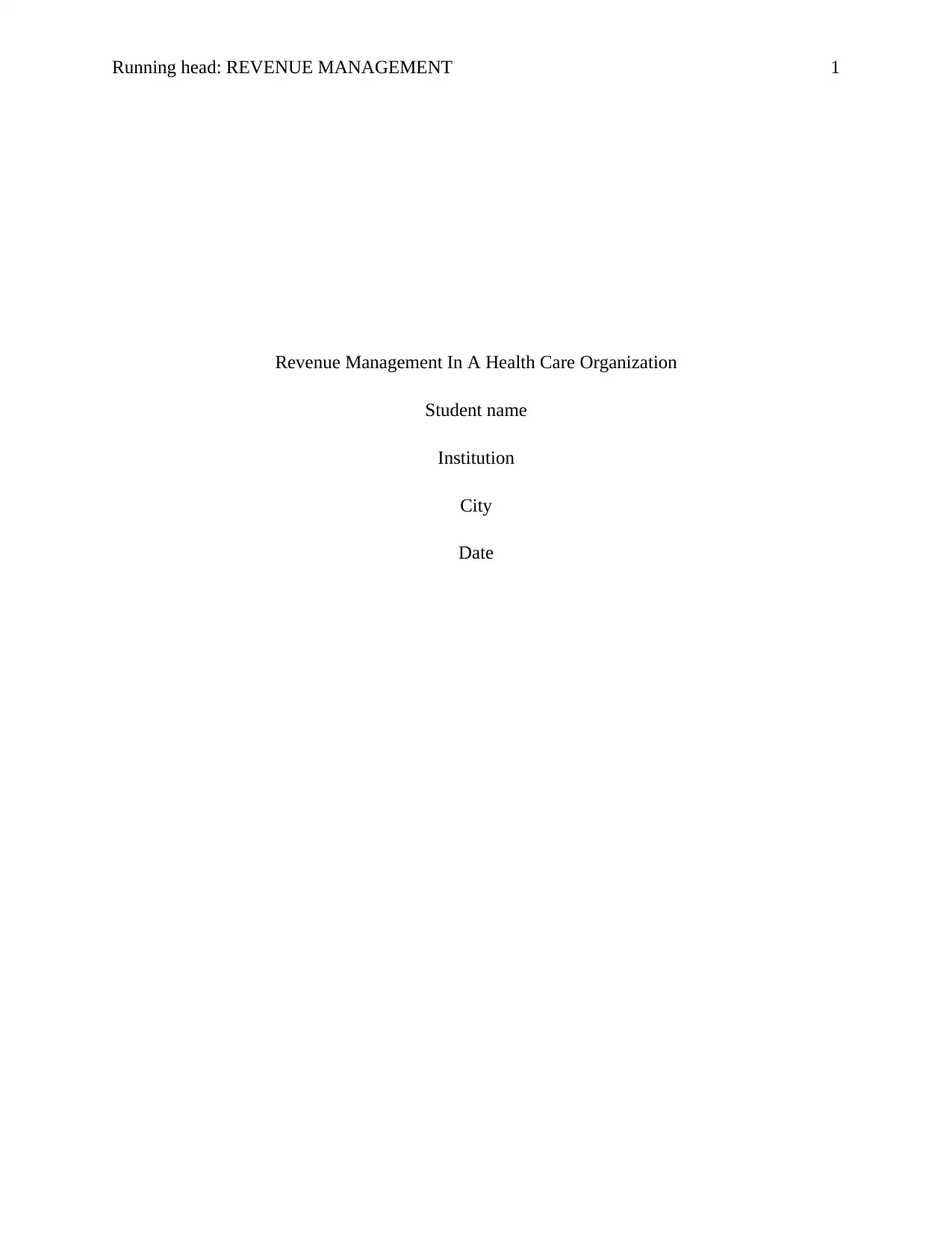
Running head: REVENUE MANAGEMENT 1
Revenue Management In A Health Care Organization
Student name
Institution
City
Date
Revenue Management In A Health Care Organization
Student name
Institution
City
Date
Paraphrase This Document
Need a fresh take? Get an instant paraphrase of this document with our AI Paraphraser
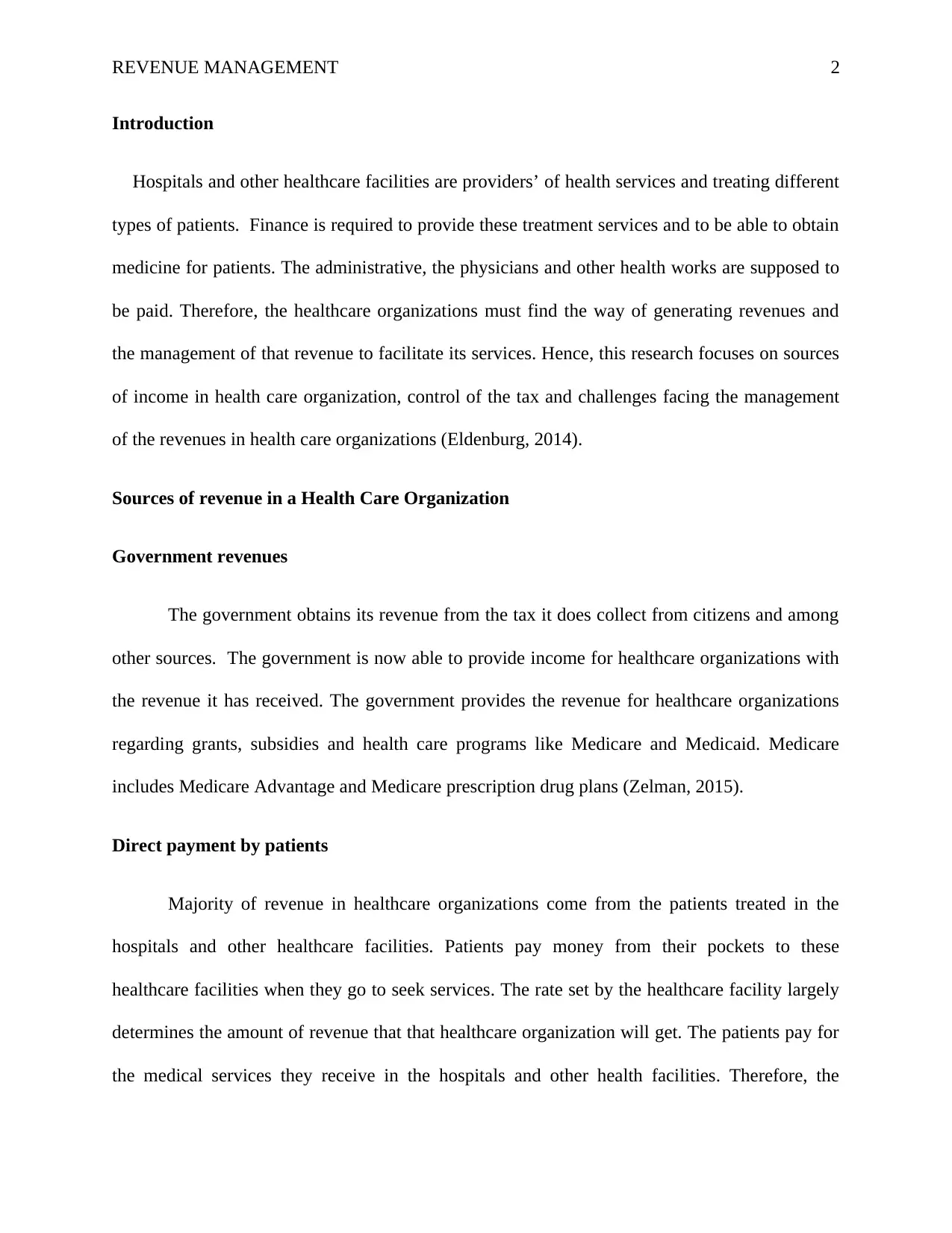
REVENUE MANAGEMENT 2
Introduction
Hospitals and other healthcare facilities are providers’ of health services and treating different
types of patients. Finance is required to provide these treatment services and to be able to obtain
medicine for patients. The administrative, the physicians and other health works are supposed to
be paid. Therefore, the healthcare organizations must find the way of generating revenues and
the management of that revenue to facilitate its services. Hence, this research focuses on sources
of income in health care organization, control of the tax and challenges facing the management
of the revenues in health care organizations (Eldenburg, 2014).
Sources of revenue in a Health Care Organization
Government revenues
The government obtains its revenue from the tax it does collect from citizens and among
other sources. The government is now able to provide income for healthcare organizations with
the revenue it has received. The government provides the revenue for healthcare organizations
regarding grants, subsidies and health care programs like Medicare and Medicaid. Medicare
includes Medicare Advantage and Medicare prescription drug plans (Zelman, 2015).
Direct payment by patients
Majority of revenue in healthcare organizations come from the patients treated in the
hospitals and other healthcare facilities. Patients pay money from their pockets to these
healthcare facilities when they go to seek services. The rate set by the healthcare facility largely
determines the amount of revenue that that healthcare organization will get. The patients pay for
the medical services they receive in the hospitals and other health facilities. Therefore, the
Introduction
Hospitals and other healthcare facilities are providers’ of health services and treating different
types of patients. Finance is required to provide these treatment services and to be able to obtain
medicine for patients. The administrative, the physicians and other health works are supposed to
be paid. Therefore, the healthcare organizations must find the way of generating revenues and
the management of that revenue to facilitate its services. Hence, this research focuses on sources
of income in health care organization, control of the tax and challenges facing the management
of the revenues in health care organizations (Eldenburg, 2014).
Sources of revenue in a Health Care Organization
Government revenues
The government obtains its revenue from the tax it does collect from citizens and among
other sources. The government is now able to provide income for healthcare organizations with
the revenue it has received. The government provides the revenue for healthcare organizations
regarding grants, subsidies and health care programs like Medicare and Medicaid. Medicare
includes Medicare Advantage and Medicare prescription drug plans (Zelman, 2015).
Direct payment by patients
Majority of revenue in healthcare organizations come from the patients treated in the
hospitals and other healthcare facilities. Patients pay money from their pockets to these
healthcare facilities when they go to seek services. The rate set by the healthcare facility largely
determines the amount of revenue that that healthcare organization will get. The patients pay for
the medical services they receive in the hospitals and other health facilities. Therefore, the
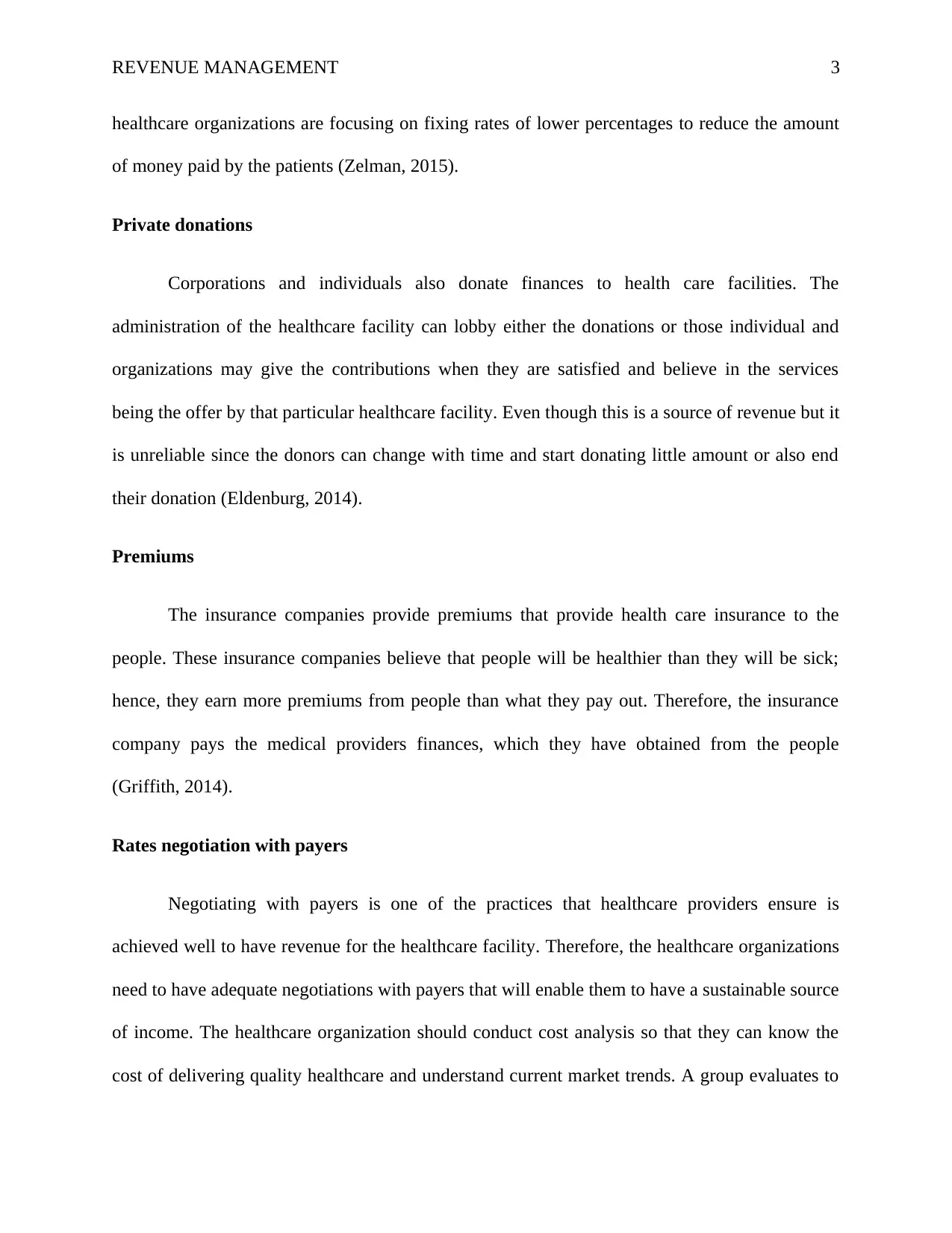
REVENUE MANAGEMENT 3
healthcare organizations are focusing on fixing rates of lower percentages to reduce the amount
of money paid by the patients (Zelman, 2015).
Private donations
Corporations and individuals also donate finances to health care facilities. The
administration of the healthcare facility can lobby either the donations or those individual and
organizations may give the contributions when they are satisfied and believe in the services
being the offer by that particular healthcare facility. Even though this is a source of revenue but it
is unreliable since the donors can change with time and start donating little amount or also end
their donation (Eldenburg, 2014).
Premiums
The insurance companies provide premiums that provide health care insurance to the
people. These insurance companies believe that people will be healthier than they will be sick;
hence, they earn more premiums from people than what they pay out. Therefore, the insurance
company pays the medical providers finances, which they have obtained from the people
(Griffith, 2014).
Rates negotiation with payers
Negotiating with payers is one of the practices that healthcare providers ensure is
achieved well to have revenue for the healthcare facility. Therefore, the healthcare organizations
need to have adequate negotiations with payers that will enable them to have a sustainable source
of income. The healthcare organization should conduct cost analysis so that they can know the
cost of delivering quality healthcare and understand current market trends. A group evaluates to
healthcare organizations are focusing on fixing rates of lower percentages to reduce the amount
of money paid by the patients (Zelman, 2015).
Private donations
Corporations and individuals also donate finances to health care facilities. The
administration of the healthcare facility can lobby either the donations or those individual and
organizations may give the contributions when they are satisfied and believe in the services
being the offer by that particular healthcare facility. Even though this is a source of revenue but it
is unreliable since the donors can change with time and start donating little amount or also end
their donation (Eldenburg, 2014).
Premiums
The insurance companies provide premiums that provide health care insurance to the
people. These insurance companies believe that people will be healthier than they will be sick;
hence, they earn more premiums from people than what they pay out. Therefore, the insurance
company pays the medical providers finances, which they have obtained from the people
(Griffith, 2014).
Rates negotiation with payers
Negotiating with payers is one of the practices that healthcare providers ensure is
achieved well to have revenue for the healthcare facility. Therefore, the healthcare organizations
need to have adequate negotiations with payers that will enable them to have a sustainable source
of income. The healthcare organization should conduct cost analysis so that they can know the
cost of delivering quality healthcare and understand current market trends. A group evaluates to
⊘ This is a preview!⊘
Do you want full access?
Subscribe today to unlock all pages.

Trusted by 1+ million students worldwide
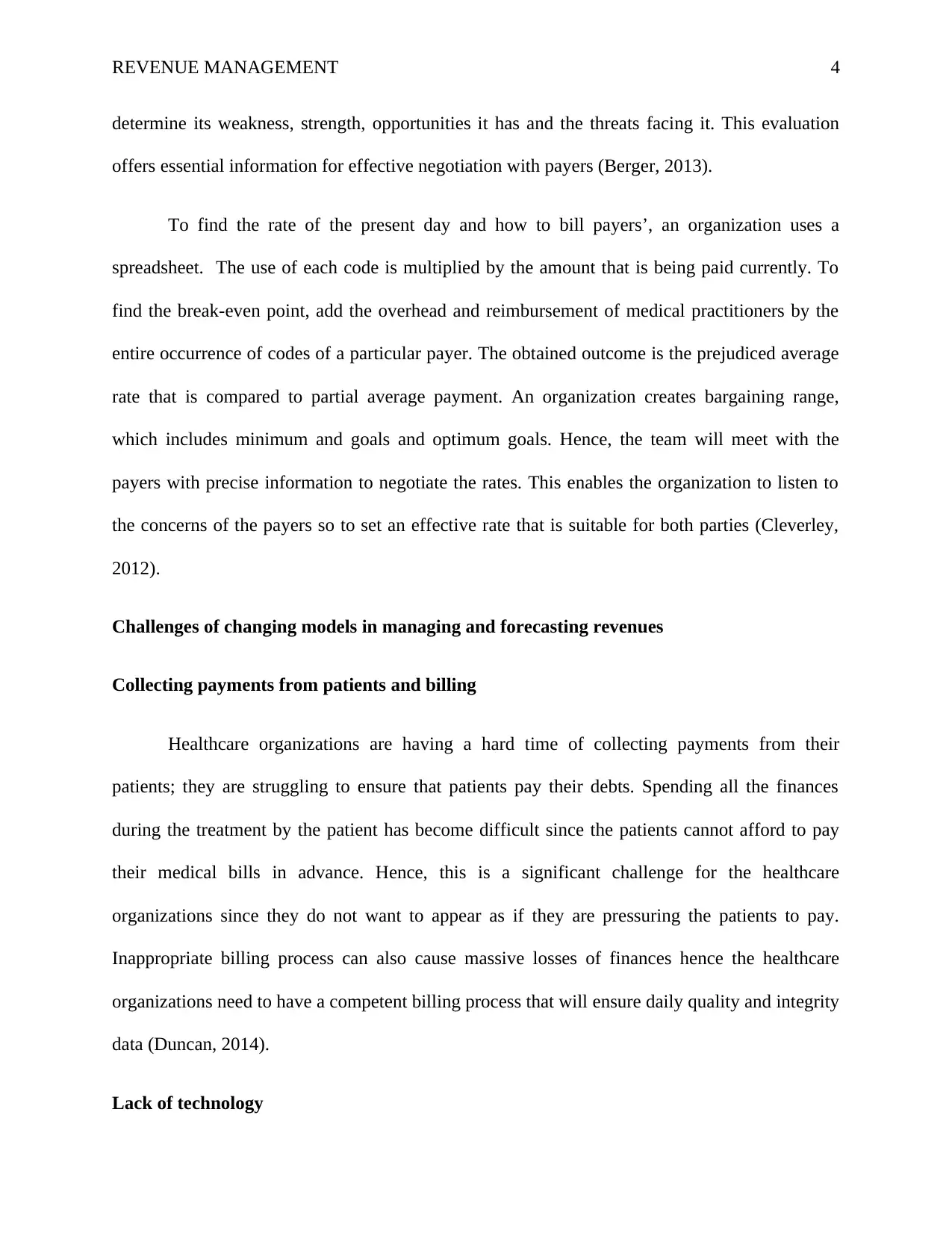
REVENUE MANAGEMENT 4
determine its weakness, strength, opportunities it has and the threats facing it. This evaluation
offers essential information for effective negotiation with payers (Berger, 2013).
To find the rate of the present day and how to bill payers’, an organization uses a
spreadsheet. The use of each code is multiplied by the amount that is being paid currently. To
find the break-even point, add the overhead and reimbursement of medical practitioners by the
entire occurrence of codes of a particular payer. The obtained outcome is the prejudiced average
rate that is compared to partial average payment. An organization creates bargaining range,
which includes minimum and goals and optimum goals. Hence, the team will meet with the
payers with precise information to negotiate the rates. This enables the organization to listen to
the concerns of the payers so to set an effective rate that is suitable for both parties (Cleverley,
2012).
Challenges of changing models in managing and forecasting revenues
Collecting payments from patients and billing
Healthcare organizations are having a hard time of collecting payments from their
patients; they are struggling to ensure that patients pay their debts. Spending all the finances
during the treatment by the patient has become difficult since the patients cannot afford to pay
their medical bills in advance. Hence, this is a significant challenge for the healthcare
organizations since they do not want to appear as if they are pressuring the patients to pay.
Inappropriate billing process can also cause massive losses of finances hence the healthcare
organizations need to have a competent billing process that will ensure daily quality and integrity
data (Duncan, 2014).
Lack of technology
determine its weakness, strength, opportunities it has and the threats facing it. This evaluation
offers essential information for effective negotiation with payers (Berger, 2013).
To find the rate of the present day and how to bill payers’, an organization uses a
spreadsheet. The use of each code is multiplied by the amount that is being paid currently. To
find the break-even point, add the overhead and reimbursement of medical practitioners by the
entire occurrence of codes of a particular payer. The obtained outcome is the prejudiced average
rate that is compared to partial average payment. An organization creates bargaining range,
which includes minimum and goals and optimum goals. Hence, the team will meet with the
payers with precise information to negotiate the rates. This enables the organization to listen to
the concerns of the payers so to set an effective rate that is suitable for both parties (Cleverley,
2012).
Challenges of changing models in managing and forecasting revenues
Collecting payments from patients and billing
Healthcare organizations are having a hard time of collecting payments from their
patients; they are struggling to ensure that patients pay their debts. Spending all the finances
during the treatment by the patient has become difficult since the patients cannot afford to pay
their medical bills in advance. Hence, this is a significant challenge for the healthcare
organizations since they do not want to appear as if they are pressuring the patients to pay.
Inappropriate billing process can also cause massive losses of finances hence the healthcare
organizations need to have a competent billing process that will ensure daily quality and integrity
data (Duncan, 2014).
Lack of technology
Paraphrase This Document
Need a fresh take? Get an instant paraphrase of this document with our AI Paraphraser
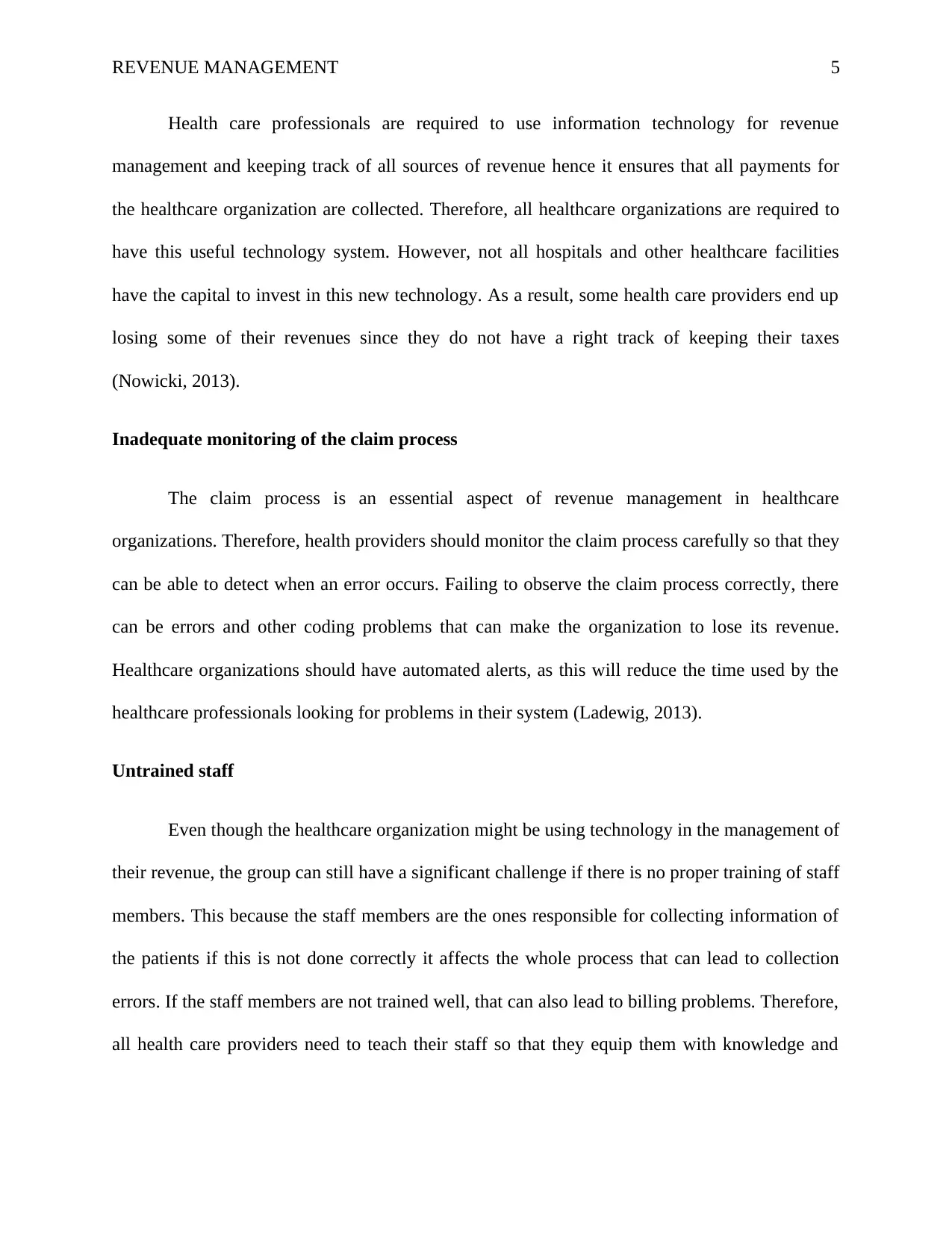
REVENUE MANAGEMENT 5
Health care professionals are required to use information technology for revenue
management and keeping track of all sources of revenue hence it ensures that all payments for
the healthcare organization are collected. Therefore, all healthcare organizations are required to
have this useful technology system. However, not all hospitals and other healthcare facilities
have the capital to invest in this new technology. As a result, some health care providers end up
losing some of their revenues since they do not have a right track of keeping their taxes
(Nowicki, 2013).
Inadequate monitoring of the claim process
The claim process is an essential aspect of revenue management in healthcare
organizations. Therefore, health providers should monitor the claim process carefully so that they
can be able to detect when an error occurs. Failing to observe the claim process correctly, there
can be errors and other coding problems that can make the organization to lose its revenue.
Healthcare organizations should have automated alerts, as this will reduce the time used by the
healthcare professionals looking for problems in their system (Ladewig, 2013).
Untrained staff
Even though the healthcare organization might be using technology in the management of
their revenue, the group can still have a significant challenge if there is no proper training of staff
members. This because the staff members are the ones responsible for collecting information of
the patients if this is not done correctly it affects the whole process that can lead to collection
errors. If the staff members are not trained well, that can also lead to billing problems. Therefore,
all health care providers need to teach their staff so that they equip them with knowledge and
Health care professionals are required to use information technology for revenue
management and keeping track of all sources of revenue hence it ensures that all payments for
the healthcare organization are collected. Therefore, all healthcare organizations are required to
have this useful technology system. However, not all hospitals and other healthcare facilities
have the capital to invest in this new technology. As a result, some health care providers end up
losing some of their revenues since they do not have a right track of keeping their taxes
(Nowicki, 2013).
Inadequate monitoring of the claim process
The claim process is an essential aspect of revenue management in healthcare
organizations. Therefore, health providers should monitor the claim process carefully so that they
can be able to detect when an error occurs. Failing to observe the claim process correctly, there
can be errors and other coding problems that can make the organization to lose its revenue.
Healthcare organizations should have automated alerts, as this will reduce the time used by the
healthcare professionals looking for problems in their system (Ladewig, 2013).
Untrained staff
Even though the healthcare organization might be using technology in the management of
their revenue, the group can still have a significant challenge if there is no proper training of staff
members. This because the staff members are the ones responsible for collecting information of
the patients if this is not done correctly it affects the whole process that can lead to collection
errors. If the staff members are not trained well, that can also lead to billing problems. Therefore,
all health care providers need to teach their staff so that they equip them with knowledge and
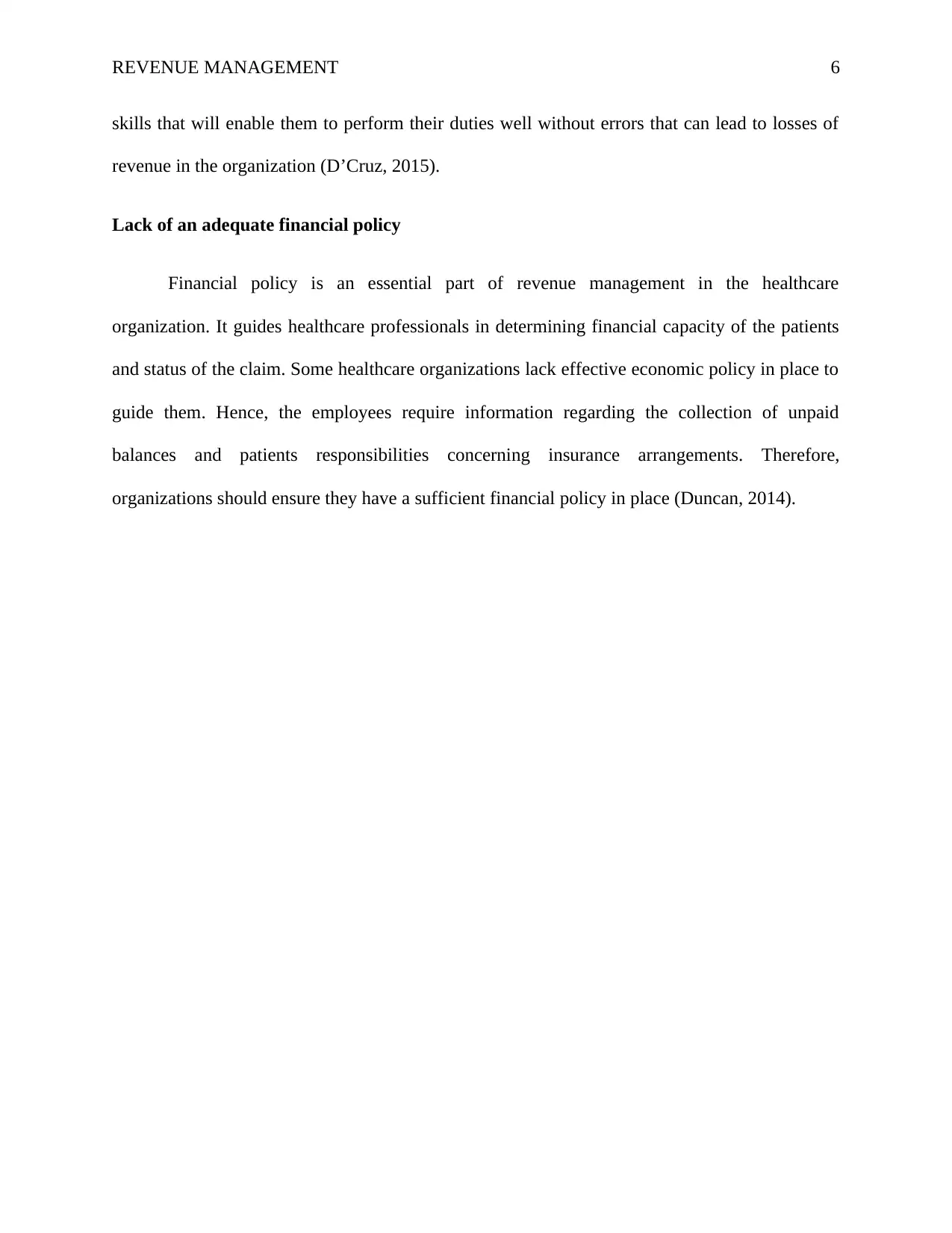
REVENUE MANAGEMENT 6
skills that will enable them to perform their duties well without errors that can lead to losses of
revenue in the organization (D’Cruz, 2015).
Lack of an adequate financial policy
Financial policy is an essential part of revenue management in the healthcare
organization. It guides healthcare professionals in determining financial capacity of the patients
and status of the claim. Some healthcare organizations lack effective economic policy in place to
guide them. Hence, the employees require information regarding the collection of unpaid
balances and patients responsibilities concerning insurance arrangements. Therefore,
organizations should ensure they have a sufficient financial policy in place (Duncan, 2014).
skills that will enable them to perform their duties well without errors that can lead to losses of
revenue in the organization (D’Cruz, 2015).
Lack of an adequate financial policy
Financial policy is an essential part of revenue management in the healthcare
organization. It guides healthcare professionals in determining financial capacity of the patients
and status of the claim. Some healthcare organizations lack effective economic policy in place to
guide them. Hence, the employees require information regarding the collection of unpaid
balances and patients responsibilities concerning insurance arrangements. Therefore,
organizations should ensure they have a sufficient financial policy in place (Duncan, 2014).
⊘ This is a preview!⊘
Do you want full access?
Subscribe today to unlock all pages.

Trusted by 1+ million students worldwide
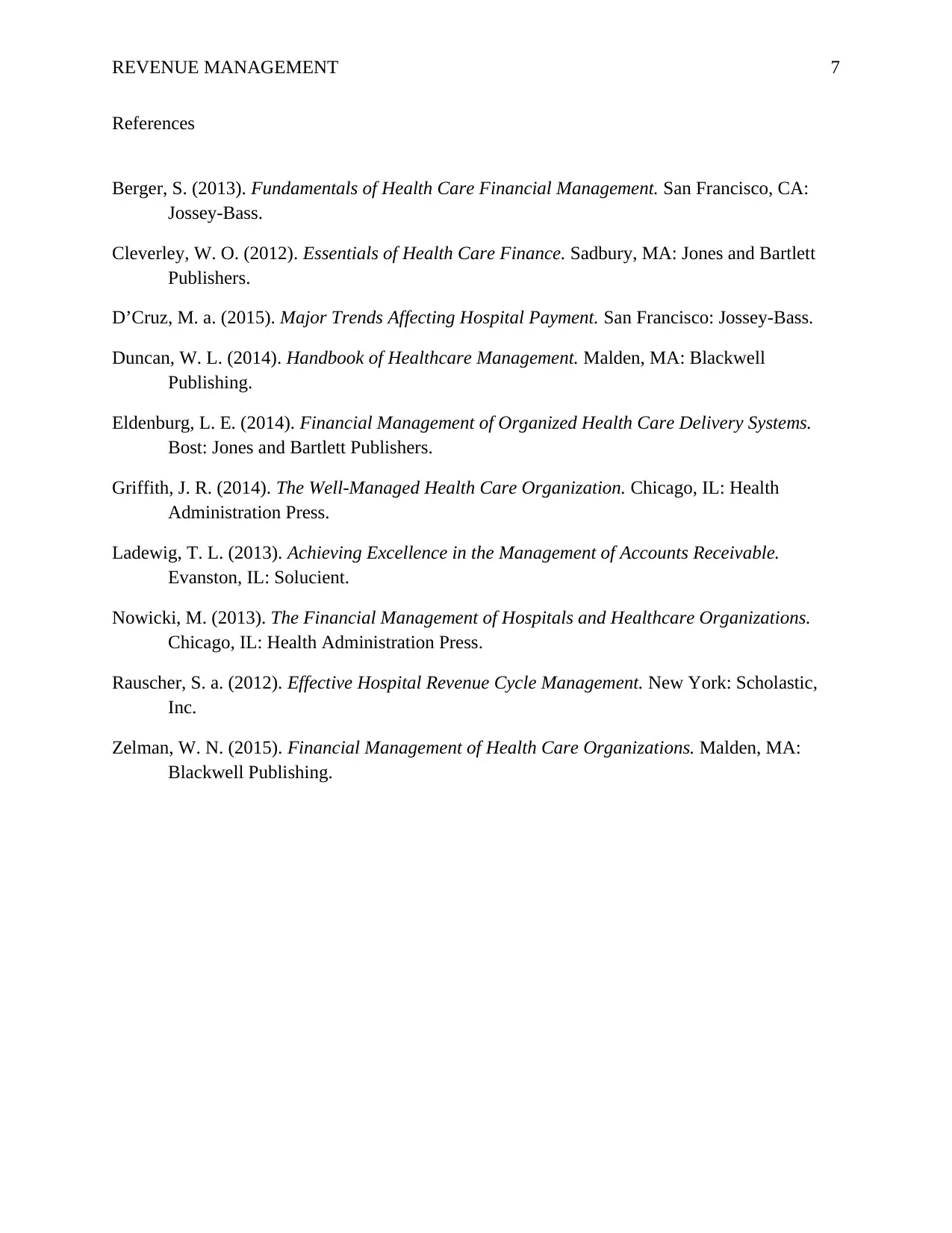
REVENUE MANAGEMENT 7
References
Berger, S. (2013). Fundamentals of Health Care Financial Management. San Francisco, CA:
Jossey-Bass.
Cleverley, W. O. (2012). Essentials of Health Care Finance. Sadbury, MA: Jones and Bartlett
Publishers.
D’Cruz, M. a. (2015). Major Trends Affecting Hospital Payment. San Francisco: Jossey-Bass.
Duncan, W. L. (2014). Handbook of Healthcare Management. Malden, MA: Blackwell
Publishing.
Eldenburg, L. E. (2014). Financial Management of Organized Health Care Delivery Systems.
Bost: Jones and Bartlett Publishers.
Griffith, J. R. (2014). The Well-Managed Health Care Organization. Chicago, IL: Health
Administration Press.
Ladewig, T. L. (2013). Achieving Excellence in the Management of Accounts Receivable.
Evanston, IL: Solucient.
Nowicki, M. (2013). The Financial Management of Hospitals and Healthcare Organizations.
Chicago, IL: Health Administration Press.
Rauscher, S. a. (2012). Effective Hospital Revenue Cycle Management. New York: Scholastic,
Inc.
Zelman, W. N. (2015). Financial Management of Health Care Organizations. Malden, MA:
Blackwell Publishing.
References
Berger, S. (2013). Fundamentals of Health Care Financial Management. San Francisco, CA:
Jossey-Bass.
Cleverley, W. O. (2012). Essentials of Health Care Finance. Sadbury, MA: Jones and Bartlett
Publishers.
D’Cruz, M. a. (2015). Major Trends Affecting Hospital Payment. San Francisco: Jossey-Bass.
Duncan, W. L. (2014). Handbook of Healthcare Management. Malden, MA: Blackwell
Publishing.
Eldenburg, L. E. (2014). Financial Management of Organized Health Care Delivery Systems.
Bost: Jones and Bartlett Publishers.
Griffith, J. R. (2014). The Well-Managed Health Care Organization. Chicago, IL: Health
Administration Press.
Ladewig, T. L. (2013). Achieving Excellence in the Management of Accounts Receivable.
Evanston, IL: Solucient.
Nowicki, M. (2013). The Financial Management of Hospitals and Healthcare Organizations.
Chicago, IL: Health Administration Press.
Rauscher, S. a. (2012). Effective Hospital Revenue Cycle Management. New York: Scholastic,
Inc.
Zelman, W. N. (2015). Financial Management of Health Care Organizations. Malden, MA:
Blackwell Publishing.
1 out of 7
Related Documents
Your All-in-One AI-Powered Toolkit for Academic Success.
+13062052269
info@desklib.com
Available 24*7 on WhatsApp / Email
![[object Object]](/_next/static/media/star-bottom.7253800d.svg)
Unlock your academic potential
Copyright © 2020–2025 A2Z Services. All Rights Reserved. Developed and managed by ZUCOL.





